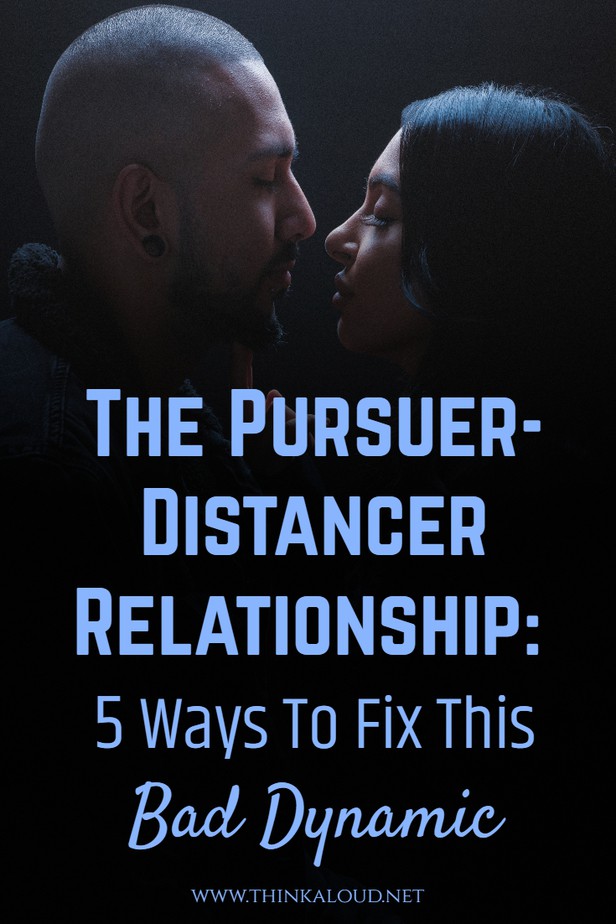The Pursuer-Distancer Relationship: 5 Ways To Fix This Bad Dynamic

A lot of times, in a long-term, committed, romantic relationship, a pursuer-distancer dynamic is created where one of the partners pursues the other.
The pursuer wants more quality time, intimacy, connection, communication, or touch, while the distancer consistently distances themselves, resisting the other partner’s bids for greater connection and affection.
The pursuer-distancer relationship is pretty much like a game of cat and mouse.
The more one partner pursues, the more the other one retreats or avoids.
The pursuer-distancer dynamic is fueled by fears of exposure, vulnerability, and intimacy by both partners.
Over the years, this dance or dynamic is perpetuated because the two people in the relationship both cast and recast their significant other in roles that are complementary.
Learning how to manage the pursuer-distancer dynamic or completely resolve it will help you bring happiness and peace into your relationship.
I said that this is a dance because every relationship can be called one, it’s just that the dance we’re talking about is very unique.
How can we define a pursuer? Well, in a relationship, their self-ascribed role is the more aware, deep, committed, and emotionally developed partner.
What about distancing behavior in relationships?
The distancer is most often cast as the emotionally challenged, less committed, colder, or simply apathetic partner.
In reality, both of their capacities for intimacy are similar, since the reality is that the distancer and the pursuer have both settled for a low level of intimacy in their relationship.
Both partners’ levels of differentiation and the ability to maintain a higher level of unique intimacy are equal.
Very often, both the pursuer and the distancer have similar core beliefs that are limiting.
For instance, they believe that relationships are dangerous or that they aren’t worthy of love.
As a result, they unconsciously agree to a certain arrangement of buffering the intimacy level by taking on the roles of the distancer and the pursuer and they are both often surprised by this equality.
We’re about to go deeper so you can fully understand the motivations of these roles.
The pursuer-distancer relationship

A secure, healthy relationship has some essential components, two of which are autonomy and connection.
Navigating needs which are conflicting, such as spending time apart and spending time together, is actually easy when everything’s going well.
However, when illness, life transitions, or other concerns make things stressful, it can be hard to balance these needs.
When one partner pulls the other one close, and the other one pushes their significant other away, it’s especially hard.
We call this type of relationship the pursuer-distancer relationship, and it has a very bad pattern, which could make it hard for the relationship to work out.
When partners experience relationship stress, this pattern often occurs.
Struggling between the need for distance and the need for closeness causes many problems for these couples.
The pursuer turns to their significant other for increased reassurance and closeness when experiencing relationship stress and their pursuit overwhelms the distancer, who withdraws to relieve anxiety, which only causes the purser to increase their efforts in order to ease the anxiety of their own, often through anger, criticism, and making even more demands.
The distancer then withdraws further, while responding critically to the demands which were added, and avoids their significant other by getting more focused on other areas of life.
The pursuer, feeling defeated after a while, can become the distancer, by withdrawing from the relationship.
The distancer then becomes the pursuer, because of the fear that their significant other will leave them.
The pursuer-distancer pattern, therefore, never ends.
During times of stress, this pattern can be normal; however, it’s problematic when it’s entrenched.
Once that happens, the way one partner acts perpetuates and triggers the way the other partner acts.
The pursuer-distancer pattern interferes with the ability of the couple to maintain a connection that is loving and causes many problems for them.
To better define a pursuer as well as distancing in relationships, let’s look at an example.
Mary and Jack are a married couple who are watching television while sitting together on the couch. Mary turns off the TV and asks Jack what’s wrong.
Jack says that nothing’s wrong and that he’s just trying to watch the television.
Mary gets upset, so she tells Jack that he never opens up but shuts down instead, refusing to share his feelings with her.
Jack says that she’s overreacting and that he has no idea what she’s talking about.
Mary tells him that he is emotionless and cold and probably even doesn’t have any feelings.
Jack leaves the room, saying he has some work to do.
Either of the partners can take on either of the roles, and it can change in different situations or over time.
The pursuer-distancer pattern can be very destructive and can lead to separation or divorce if it keeps being a regular part of a relationship.
Understanding the pursuer/distancer roles

To master the pursuer-distancer dance, we need to fully understand the roles, which can be hard to do.
Honestly embracing who we are as well as who our loved ones are is necessary in order to accurately identify our emotional needs and our roles.
1. The pursuer
Others see the pursuer as a righteous martyr who only wants more intimacy in their relationship, while they don’t get minimal appreciation for their heartfelt efforts, and they see themselves in the same way.
The reason for this is often the fact that they believe that they aren’t worthy of love; therefore, they unconsciously choose a partner who, also unconsciously, validates these feelings by acting superior and distant.
Eventually, the pursuer starts feeling that they have to settle for what the distancer, their partner, is willing to give, which is often crumbs.
The partners who are distancing in relationships may perceive the pursuers as clingy, desperate, and even pathetic.
The pursuer experiences losses, which are, most of the, time quite evident; an overall frustration that could even make them feel humiliated, a sense of rejection, a lack of intimacy and love in the relationship, low self-esteem, or feeling taken for granted, invisible and unappreciated.
Pursuers are usually less aware of their gains as well as less willing or ready to own up to them.
They usually find that they gain control over vulnerability and intimacy by always being the initiators. Pursuers are in control in that way.
They pursue when they want attention, and when not, they just don’t initiate.
A pursuer is often considered the hard-working partner, the one who makes sacrifices, while the other partner neither reciprocates nor appreciates.
2. The distancer

Distancers tend to be more connected to the secondary gains they get than losses.
While feeling superior to their partner, who’s always begging for intimacy, what they gain is a sense of control.
They feel forever desirable, because of the fact that they’re constantly pursued, regardless of the things they do in the relationship or the things they don’t do.
This gives them a sense of security because they know the pursuer will never leave them, regardless of how they behave.
They aren’t really aware of the secondary losses of being a distancer, one of which is a sense of loneliness in the relationship.
Distancing behavior in relationships makes these people experience that showing weakness or a need for affection the pursuer will interpret as a demand or a complaint. Pursuers need more proof because they don’t feel like the distancers are really invested in their relationships.
The pursuer-distancer dynamic results in the pursuer minimizing or rejecting the distancer’s wishes and this so-called dance is off-balance.
3. The attraction
The reason why the pursuer and the distancer are so drawn to each other is that each of them has what the other one lacks.
Distancers see pursuers as being ambitious, passionate, and direct. Pursuers see distancers as confident, calm, and self-reliant.
When problems occur, their natural opposite reactions create anxiety, which reinforces the pursuer-distancer pattern.
The pursuer starts insisting on connection even more and increases their emotional response, and the distancer withdraws further as a response to this increase in intensity.
The pattern is more deeply ingrained each time the trouble occurs.
4. The reversal
Near the end of this type of relationship, a reversal of roles happens, just like it happens in a demand-withdraw relationship.
After continually being rejected, the pursuer eventually stops pursuing.
They appear angry, tired, cynical and irritated most of the time, they start making less eye contact, and their body language becomes closed off.
When the distancer stops being pursued, they become unsure of themselves and of who they really are, because their self-perception is based on their partner’s unbridled devotion.
The withdrawn, weary and angry former pursuer now becomes pursued by the desperate distancer.
The distancer falls back in love with the pursuer just as they finally leave.
5. Which one are you?

Do you ever long for your significant other and wish you could start feeling more connected, even at times when the two of you are in the same place?
Maybe you instead catch yourself fantasizing about having a break from the relationship and wish you could, at least for a while, simply slip away?
Most relationships are made of one partner who needs more distance, while the other one needs more closeness.
If you’re in a relationship, the interesting question you should ask yourself is which one of them are you?
Do you wish your relationship could be closer? Maybe you instead feel like your significant other’s too close for comfort?
How do you try to get what you need if you’re the one who needs more closeness?
In what way do you try to have more separation if you’re the one who needs more distance?
Most importantly, are these ways you’re using working for you?

Pursuers need and want closeness, affection, and attention in order to feel cared for and secure.
Talking things out has a high value for them, as well as expressing feelings, and when their significant other needs space, they feel personally rejected.
That feeling results in asking many questions, making complaints, or criticizing the distancer in an attempt to establish reconnection.
The underlying needs are a need for reassurance and a need for a deeper connection.
Unfortunately, because of the pursuer’s reactive behaviors, they often push the distancer away and therefore create more distance.
When there’s a lot of stress, distancers seek physical space and emotional distance.
They enjoy autonomy and independence, and when they feel anxious in a relationship, they often turn inward and become quiet.
Their tolerance for conflict is low, so they manage their relationship by intensifying activities outside of their relationship, as well as work.

They actually do need and want connection, but their avoidant behaviors cause criticism, and that leads to withdrawing further.
People who you attract into your life have characteristics that you have unconsciously disowned; that is why pursuers and distancers often have relationships with each other.
Pursuers aren’t aware of needing autonomy and pursue intimacy, while distancers aren’t aware of needing intimacy and seek autonomy.
Both of them have to develop some of the qualities the other one has in order to achieve balance and have a better relationship.
How to fix the pursuer-distancer dynamic
Many interactions between partners get stuck in a never-ending cycle of distancing and pursuing, and it’s not a surprise since many couples don’t understand this relationship dynamic and don’t have an insight into the underlying needs and styles each other has.
To stop this behavior and turn the pursuer-distancer relationship into a healthy one, both partners have to find a balance between connection and solitude of their own. Both partners should be able to connect with one another, as well as be alone.
Let’s see what they can do individually.
1. What can the pursuer do?

Changing this pattern most of the time starts with the pursuer, since they are more concerned regarding the distance and, therefore, more motivated to fix the problem.
If you’re the pursuer, you need to figure out how you can stop the chase. You should acknowledge your needs as well as clearly state that you’re the pursuer.
Start meeting your own needs by creating experiences outside of your relationship, instead of wanting your relationship to meet all of them.
You can deal with your relationship anxiety by learning to self-soothe, therefore decreasing the criticism and demands.
Embrace your need for independence, and you won’t turn to your partner to relieve your anxiety but turn to them for interconnection instead.
2. What can the distancer do?

If you’re the distancer, you can also change this pattern, but you need to focus on your own behavior.
Schedule a time to physically and emotionally connect with your partner, and don’t forget that you can also schedule some alone time.
The pursuer’s anxiety and need to pursue will be decreased once they know that a time for connection is scheduled.
Try being more vulnerable with your significant other. Share your thoughts, your day, and your feelings, and start actively listening to your partner.
If needed, you can ask for time and space to think about some problem your partner has mentioned.
Let your significant other know when you’re planning to discuss the issue once you have asked for that space and time.
Once you start choosing to support your significant other in hard times instead of choosing to withdraw, the two of you will manage to have a better balance between togetherness and independence.
The pursuer-distancer dynamic becomes a problem once it’s entrenched.

Once you notice this pattern starting to be more prevalent, it will be very important for the health of your relationship to stop it.
If it’s too hard for you to do this on your own, you can always try couples counseling.
You’ll be able to create the successful relationship that you want to have once you learn to acknowledge and meet your partner’s attachment needs, as they will with yours, without going back to a destructive pattern like this one.
In the pursuer-distancer dynamic, both of them settle for a low level of intimacy, and the way their dynamic validates the low self-esteem they have.
However, what they most of the time don’t realize is that there are constant moments where their behavior is different from the one expected from their role.
These moments are often overlooked, but it’s in them that the chance for change and growth resides.
Some ways you can fix this problem
Identifying, softening, and liberating yourself from this so-called dance are the ways to go. Here’s what you can do.
1. Think about your romantic relationship and figure out whether you’re the distancer or the pursuer

Think about the overall dynamic of your relationship, beyond specific examples.
Does one of you always avoid things, while the other one always wants more?
Identifying the levels of commitment and realizing how they work in your relationship is crucial if you want to solve this problem.
2. Write down everything that you’re losing and gaining from your role

You need to be aware of everything that you’re losing and gaining from your role, so write it down, and then help your partner do the same or write down the losses and gains for them.
Is it possible to have all the benefits in some different way? How can you move forward and what can you do about it today?
How about your partner?
Take into consideration all the avenues of gain and loss for both of you.
3. Acknowledge that you are both on the same level

You need to accept that you and your partner are both on the same level, which includes emotional intelligence, and maturity, as well as differentiation.
Feeling inferior or superior to your significant other will always get you back to the same bad dynamic.
To find solutions that work, you’ll have to be equal.
4. Have you discovered that you’re the pursuer?

A lack of intimacy in your relationship is not solely your partner’s fault, so you have to stop blaming them for it. Stop pursuing them.
Most of the time, the pursuer’s greatest fear is that there won’t be any intimacy and that the distancer will simply walk away and leave them if they stop pursuing.
You need to realize that that’s the risk you must be willing to take if you want things to change and for this bad dynamic to stop.
Once you stop pressuring and pursuing your significant other, they won’t need to keep running away from you anymore, so they’ll confront themselves and figure out what it is that they want from a relationship with you.
You have to start focusing on the ways you can fulfill your own needs. Realize that you can do that by yourself.
When it comes to your needs within your relationship, you need to discover new ways to fulfill them.
Think about the ways you can celebrate yourself a little more and discover new avenues for affection and expression without having to break the commitments of your relationship.
Don’t be surprised when the distancer behaves suspiciously or defensively at your brand new repertoire because it’s simply their way to induce you to your position as a pursuer.
You shouldn’t be worried about it, because it’s just a natural part of the process of change.
5. Have you discovered that you’re the distancer?

Don’t blame your significant other for pressuring you and don’t blame them for making your relationship so tenuous or draining.
You need to start connecting to your loneliness as well as realize how vulnerable and sensitive you truly are.
Dissociating from those feelings or avoiding them most often leads to distancing behavior in relationships.
You have to find ways to express your needs and feelings.
Dare to ask for intimacy in any way that seems comfortable for you, and try to be the initiator.
Don’t be surprised when the pursuer causes drama or turns to guilt trips.
All of that is just a part of your bad dynamic and things you have to deal with when you’re changing it.
Step out of your roles, and you will be able to have a much healthier relationship.







